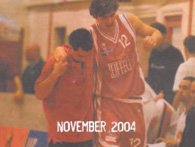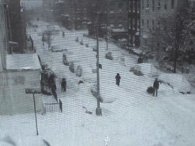Getting Started
| We talked in Chapter 4 about framing shots. Wide shots are usually used to establish context, because they show more information about where your subject is physically located than close-up shots. Close-ups, on the other hand, are good for revealing something about your subject's character or emotions. Sometimes you need a variety of shots to tell a story, but sometimes you don't. If you choose to capture your whole story in one shot, for example, your editing workload is going to be pretty light. The videos shown in Figures 5.1 and 5.2 illustrate the extremes of video editing. Though they're very different, the story of each video is clearly defined. Figure 5.1. Eric Nelson is a professional basketball player. In "The Knee Year," he uses footage shot over the course of a year to explore his journey from knee surgery, through rehab, to playing in a game again. You can find it at http://bottomunion.com/blog/?p=117
Figure 5.2. "Brooklyn Snow Storm," at http://www.scratchvideo.tv/scratch/2006/02/brooklyn_snow_s.html began as a single 30-minute video shot, which was then speeded up in editing so that it all elapses in one minute.
The first step of editing is to view your footage and decide which portions define or shape the story. If you started out with a plan, when you edit you will arrange your shots according to your notes, script, or storyboard. Sometimes the story that you shot is not exactly the story that you planned. Either something completely unexpected happened or things just didn't quite turn out the way you thought they would. This isn't a bad thing. Editing is a magical process. It's often the unexpected shot that turns out to be the gem of a piece. Videos for vlogs are generally pretty short, so part of the shaping process is trimming material you don't need so your audience sees just the good stuff. Review your footage with several questions in mind. Does a particular shot move the story forward or give the audience important information? If not, you'll want to set that shot aside. Are there two shots that tell viewers the same thing? Maybe you can cut one out to move the story along more quickly. Remember, you're not making The Godfather; you don't have 10 minutes to establish the setting, time period, and main characters before getting to the main story. As you trim the fat and focus your story, you'll be selecting and organizing specific shots into a sequence that flows together. This is where you'll use wide shots, close-ups, and medium shots to tell your story in a way that makes sense. All the while, especially if you're new to working with video, you'll notice how things might fit together better if they'd been shot a little differently. There's a symbiotic relationship between shooting and editing. Learning how to edit will make you a better shooter, and becoming a better shooter will make editing easier. The really great thing about this process is that you're constantly learning and becoming a better storyteller.
|
EAN: 2147483647
Pages: 81

